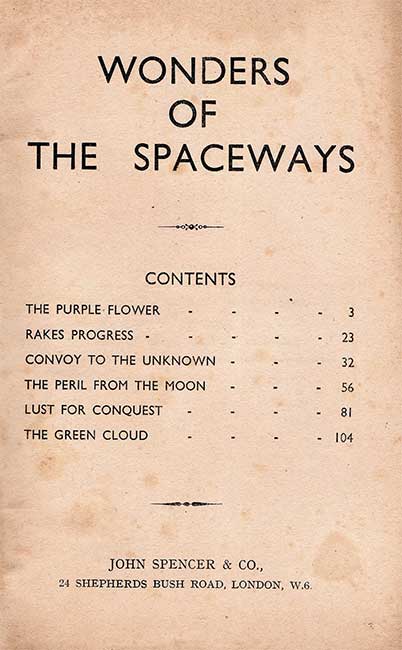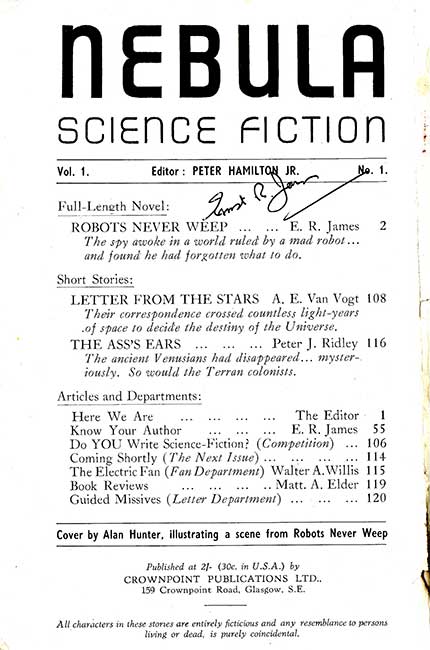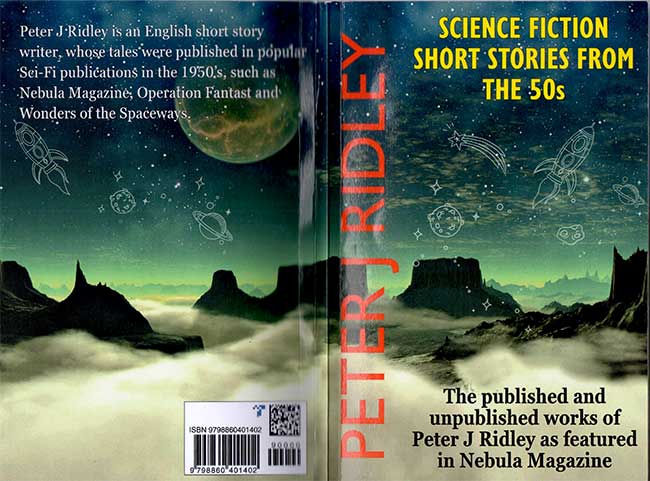
Review of:
‘PETER J RIDLEY: SCIENCE FICTION
SHORT STORIES FROM THE FIFTIES’
(2023, ISBN 979-886040-1402)
What Peter J Ridley terms ‘the chemical reaction we call life’ was different in the 1950s. The air of Venus was breathable, although the planet hides nasty secrets. There are space freighter lines from Mars to Earth via the Moon Harbour. The pilot punches out landing tape to feed into the ship’s controlling Brain. And he smokes his favourite brand of cigarette, even on an alien planet.
For Peter, the discovery of SF happened in spurts. First there was HG Wells, who crammed head-spinning concepts into reader’s heads and inspired so many young writers. Then there were the gaudy visual exploits of Flash Gordon and Buck Rogers, picture strips in comics sent from America by his Aunt. But the real catalyst was picking up a copy of ‘Amazing Stories’ from a bookstall located outside a London tube station. He was just eighteen years old, employed as a messenger boy at an artist’s agency. He had artistic ambitions himself, which led to him contributing his artwork to fanzines, a portfolio of which are appended in the last few pages of this 2023 collection, the first of them dated July 1949.
But by then, fiction had entered his bloodstream like a powerful narcotic, so he enrolled at Eltham Lit College in Mottingham, southeast London, where he began writing stories, hunched over his typewriter in a small Eltham backroom. A selection of those tales appear in print for the first time here.

‘Wonders Of The Spaceways’ provided the gateway up from a few fanzine appearances into pro but low-prestige publications. It was a small and garish pocket-book from the trashy shoestring ‘John Spencer’ stable of titles. ‘Rake’s Progress’ is a problem-solving story, when the space tramp ‘Don Juan’, on route for Ceres, encounters a dumbbell-shaped asteroid composed of solid magnetite, it traps them to its surface. The crew eventually ‘paint’ a solenoid around the asteroid in order to temporarily deactivate its charge sufficient to lift off. The tale hangs together well as an example of tech hard-science ingenuity, and asteroid 216 Kleopatra has indeed been subsequently shown to display a dumbbell appearance!

Then there was ‘Nebula’, a step up further, with a welcome extended by reader Ken Potter to the effect that ‘Ridley’s break into the prozine was very good to see.’ Edited by Peter Hamilton from an address in Scotland, ‘Nebula’ was a beautiful and fondly remembered little magazine that ran for forty-one issues from October 1952 through to June 1959, featuring writers luminous in their day, such as EC Tubb, William F Temple, FG Rayer, Philip E High and Eric Frank Russell. There were just three tales included in the debut issue, readers discovering Peter’s ‘The Ass’s Ears’ alongside stories by AE Van Vogt and ER James. With a title-reference to the old King Midas myth, Peter’s is a brief but highly readable tale set on Venus. The narrator suggests the fate of the extinct humanoid native Venusians, without actually spelling it out, after observing ants trap a large toad in a concealed pit. But it’s also a story about contemporary issues such as alcoholism, exploitation and the suppression of truth.
I came along much too late to enjoy ‘Nebula’ while it was still being publishing. I only discovered issues in a second-hand bookshop in Hull, while I was working as a print apprentice. At lunchbreak I would cycle a little way down to the bookshop, and select a magazine with an exciting cover, of a spaceship or a robot. It was only a little while later that I began to fill in the gaps between the issues I had, with the issues I didn’t have, until eventually I had a complete run.
The writers in those issues seemed like gods to me, and discovering each new story opened up my teenage mind to new and exciting possibilities for the future that I would be living. I was so grateful that I was eventually able to meet some of those writers and tell them just how much their work meant to me.
And now I’m in the fortunate position to tell Peter that same thing!
He returned in issue four with ‘…And It Shall Be Opened’, acclaimed by reader T Murray as a story that ‘reveals up-to-the-minute detailed knowledge of present-day thought in matters of space flight. A human and moving story.’ When the Captain of the ‘Star Witch’ dies just seven days out from Mars, the mix of crew and diverse passengers have to deal with an oxygen leak that will kill them all before they reach Moon Harbour. Harrison has to overcome the empyriphobe fear of naked space that has branded him a coward and a failure, in order to rescue a naïve young Ghyll who has ventured outside to trace the puncture.
Ridley ventured to The White Heart tavern on New Fetter Lane, just north of Fleet Street, where the SF community would gather informally, yet in awe of writers such as John Beynon (John Wyndham), Sam Youd (John Christopher) and Arthur C Clarke (who would fictionalise the meetings in his 1957 ‘Tales From The White Hart’ collection).

He returned to ‘Nebula’ after a few years break, apologising ‘it is, I must admit, some time since I bought a copy, and possibly for this reason I am more easily able to discern the degree of advancement made since the early days. The reading matter – now apparently largely home grown and original, is greatly improved.’ He goes on to praise the ‘glossy style’ of ‘Ted’ Tubb and the ‘atmospheric’ John Brunner, while criticising the ‘garish childishness’ of the illustrations, ‘regular readers are, of course, not much worried by the standard of the artwork, but bookstall-browsers who might become regulars are inclined to judge the apple by its skin’ (a letter in no.20). Peter Hamilton responds with a detailed dialogue defending his artists, but when Ridley appears with a new story of his own in no.22, it is not illustrated!
‘Morality’ is a gentle tale, with Karnak – ‘dried, and etched with years’, arriving at a seemingly idyllic planet after years of restless spacefaring, only to discover the world’s dark secret. There are a number of levels to the tale, despite its relative brevity, concerning ageing and youth, first in Karnak’s relationship with his daughter, Antigone, who prefers the isolation of space to human company, and then in the seemingly youthful inhabitants of the golden city who fear ageing so much that they hide behind youthful guises. For a young writer, it shows an impressive degree of perception.
Space gipsy Karnak was to return. First in the previously unpublished ‘It’s Cold Outside’, which is an extended meditation on life and death as he is marooned, floating in space, only to be ironically saved by a meteor that takes off his finger, but by doing so releases a jet of escaping air sufficient to nudge him back into the airlock. Then Karnak features in ‘Wish Upon A Star’ – Ridley’s final contribution to ‘Nebula’ (no.31, June 1958), where he’s in an issue stacked up against fiction by Robert Silverberg, Brian W Aldiss and EC Tubb. In the editorial Peter Hamilton claims Ridley as ‘another of my discoveries’ and expresses the hope that this will be the ‘forerunner of many more unusual stories by this very original new writer.’
Karnak lands on planet Arachne 4, only to discover it strangely familiar, to an unsettling degree when he starts to see his dead wife, Gina, approaching him from the estuary. As he flees in horror, the story ends on a nicely ironic humorous twist. The planet is a real-estate construction, a ‘psychoplasm that anticipates your every desire.’
‘Lowering my memory bucket down a seventy year deep well is a long job!’ Ridley says now, ‘I had it in mind to develop Karnak and his daughter into a series with K himself being a kind of freelance space explorer, but that didn’t happen.’
There are some hidden gems among the other, previously unseen bite-sized tales, which derive from a writing course he attended. ‘By The Shore Of The Loud Sea’ is virtually a tone-poem of vivid phrasing as he walks the storm-edge of a shoreline he uses Homer’s ‘wine-dark sea’ to describe. In what is almost a vignette he encounters a stranded mer-woman with vicious shark-teeth, he’s wary, but enticed to assist her back into the waves. He recalls ‘I can tell you that when I wrote the story about the mermaid I was influenced both by visits to Cornwall’s dramatic coast and my reading of some Penguin Book translations of ancient Greek writers. The latter also had a part in my development of the characters of Karnak and his whinging daughter.’
In ‘Back Seat Driver’ the Galactic Bureau’s policy of using a married couple to crew exploration starships results in the perfect Fifties Housewife in space, frying bacon, laying the table with fresh linen and hanging bright curtains around the spaceship ports that look out on empty space! But when they get into a First Contact situation with an alien ship, which he intends to destroy, she sensibly advises caution and so probably avoids interstellar war. ‘The Longest Laugh’ involves a rainforest planet among naked humanoid natives, on a quest for an exotic consciousness-raising drug called ‘Augmenticin’.

A favourite of mine is ‘The Traitor’, set on a Mars typical of so much Fifties SF, where lost cities left by extinct Martians conceal both fabulous treasures and hair-raising terrors. A Sand Rover team discover an ancient pale pink building that ‘resembled nothing more than one of the Kentish Oasts that Sheffard knew so well.’ The building contains gold and precious stones, but the centrepiece is wood, ‘wood was a much rarer commodity than either gold or diamonds in this treeless place.’ When they are trapped inside its walls by a sandstorm, rivalries and greed lead to murder. The sole survivor escapes and intends to respect the dead Martians by keeping their secret.
But there was to be no more fiction. How it is possible to write, and to be published, and then to cease, despite the financial pressures of family life? Surely writing its a kind of addiction that is impossible to shake off? ‘Not so,’ he confides, ‘with regard to my giving up writing for commerce, this I think arose from my basic nature, I am a realist with a tendency to pessimism, and did not believe that my fiction writing was good enough to be a viable source of income. When I met my wife in 1958, I could see that my income from an undemanding job supplemented by occasional sales of writings would not support a wife and children, so I set about obtaining a commercial qualification. This took up all my time, and fiction writing ceased!’
With Peter now in his mid-nineties, living in Hampshire with June, his wife of sixty years, it is daughter Francesca who assembled, designed, and lightly edited this collection. ‘Back in the fifties the English language was more eloquent, stirring and persuasive’ she suggests, ‘and Peter’s writing displays that in abundance.’ Instead, he chose to develop his creativity into water colour painting, and by co-authoring a book of biographies of local First World War victims. But sadly, no more science fiction, concluding ‘my fiction writing days were a very long time ago.’
What Peter J Ridley terms ‘the chemical reaction we call life’ was different in the 1950s, this collection of tales provides a series of unique glimpses into those lost tomorrows.
BY ANDREW DARLINGTON
WORKS BY PETER J RIDLEY
‘Dead World’ (‘Operation Fantast no.4’, March 1950) short fiction in Captain Ken F Slater’s fanzine.
‘Longevity And The Superman’ (‘Operation Fantast no.6’, September 1950) An essay.
‘Rake’s Progress’ (‘Wonders Of The Spaceways no.1’, November 1950), uncollected fiction.
‘Choose Your Weapons’ (‘Slant no.5’, Spring 1951) fiction in Walt A Willis fanzine. Ridley says ‘I recall writing a story concerned with two adversaries fighting it out on a small asteroid, one armed with a laser weapon, the other with an old-fashioned rifle. It may have been called ‘Choose Your Weapons’. This was sparked off by my reading the novel ‘Brown On Resolution’ by C. S. Forester of Hornblower fame, although the two stories were markedly different.’
Cover and interior art for ‘Operation Fantast Newsletter’ (June 1951)
‘Strangers Under The Sun’ (‘Phantasmagoria’) 24-page fanzine edited by Derek Pickles from Bradford, reviewed in ‘Authentic Science Fiction no.11’ as Ridley’s ‘a longer story… has pride of place at the beginning of the mag.’
‘With Apologies To Marvel Science Stories’ (‘Science-Fiction Five Yearly no.1’, November 1951) interior artwork in the fanzine edited and published by Lee Hoffman.
‘The Ass’s Ears’ (‘Nebula no.1’, October 1952)
‘…And It Shall Be Opened’ (‘Nebula no.4’, June 1953) fiction with Terry Jeeves art.
Readers Letter in ‘Nebula no.20’, March 1957)
‘Morality’ (‘Nebula no.22’, July 1957)
‘Wish Upon A Star’ (‘Nebula no.31’, June 1958)
‘It’s Cold Outside’ (first published 2023)
‘By The Shore Of The Loud Sea’ (first published 2023)
‘Back Seat Driver’ (first published 2023)
‘The Longest Laugh’ (first published 2023)
‘The Traitor’ (first published 2023)
‘PETER J RIDLEY: SCIENCE FICTION SHORT STORIES FROM THE FIFTIES’
Collection (2023, ISBN 979-886040-1402)
